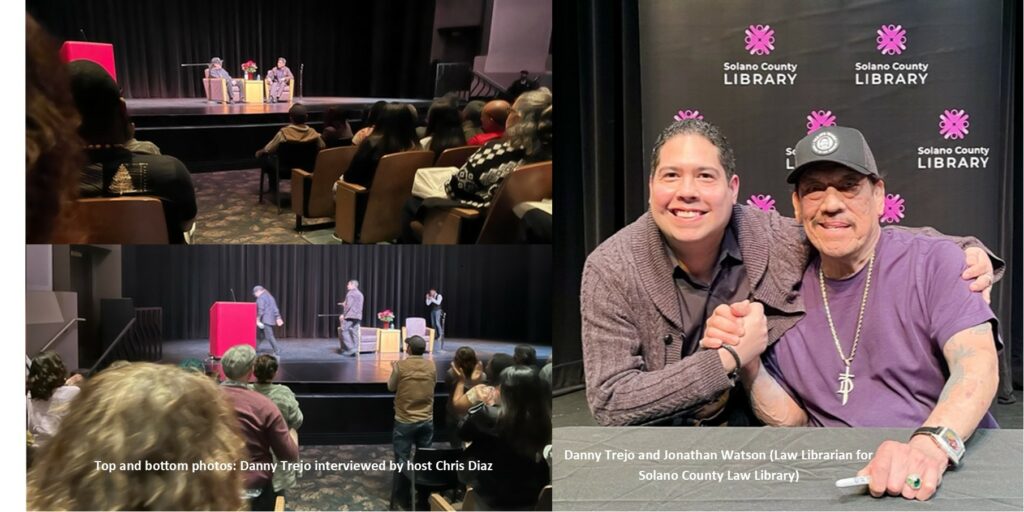“Restraining Orders and the LGBT Community” by Jonathan Watson Although this may sound like a…
From the Law Librarian’s Lectern: Danny Trejo and Recidivism in California (January/February 2024)
by Jonathan Watson

On January 27, 2024, I had the pleasure of attending the Solano County Library program “Danny Trejo Talks Redemption, Hollywood, and Tacos”. During his interview with Digital Community Librarian Chris Diaz, actor Trejo discussed his memoir Trejo: My Life of Crime, Redemption, and Hollywood (co-written with Donal Logue) and touched upon topics such as sobriety (including his work as a youth substance abuse counselor), breaking the cycle of recidivism, and his decades-long film career and various entrepreneurial ventures.
After his last prison sentence ended in 1969, Trejo has spent his life reinventing himself. Still, there might be some detractors that would find his former prison stints and views on prison reform controversial. Yet, if Martha Stewart and Robert Downey Jr. can serve time in prison and receive accolades for their new chapters in life, why not Trejo? Trejo remains active in his cause and has appeared in documentaries such as “Survivors Guide to Prison” (2018) in the hope of expanding people’s viewpoints about the criminal justice system. In 2013, he was even the keynote speaker at a ceremony for Tulare County Adult Drug Court graduates (The Recorder, 2013). As quoted by McConnell (2024), Trejo lives by the philosophy that “Everything good that has happened to me has been a direct result of helping someone else”.
In a 2021 interview, Trejo expressed his frustration that the “California Department of Corrections spelled backwards is recidivism…Because that’s what happens that the whole structure is built to come back. If I ran a business with 80% failure, I’d change my business. But they got 80% failure, and 10% of the people in prison belong in prison” (Goeres, 2021). How does his viewpoint compare with the latest state of prison reform in California?
Recidivism is “a tendency to relapse into a habit of criminal activity or behavior” (Black’s Law Dictionary, Ninth Edition). According to Watts (2023), “recidivism [in California] has largely held steady since 2012, hovering between 44.6%-46.1%”. The 2019 report “California Department of Corrections and Rehabilitation: Several Poor Administrative Practices Have Hindered Reductions in Recidivism and Denied Inmates Access to In‑Prison Rehabilitation Programs” (California State Auditor) confirmed that the recidivism rates have averaged around 50% for the past decade. For background, the report cited the 2011 U.S. Supreme Court order which required California prisons to reduce their inmate population by 137.5% by providing “mental health and medical treatment that met constitutional standards”.
That same year, the California legislature passed Assembly Bill 109 (2011). Referred to as “California Criminal Justice Realignment”, the aim was to “to punish low-level felony offenders with local jail or out-of-custody “mandatory supervision” instead of prison”. In her analysis of the CDCR’s “RECIDIVISM REPORT FOR OFFENDERS RELEASED FROM THE CALIFORNIA DEPARTMENT OF CORRECTIONS AND REHABILITATION IN FISCAL YEAR 2017-18”, Watts (2023) stated that “roughly half of the inmates who were released…participated in rehabilitation and other in-prison programming before release”. Due to the lack of certain data, though, Watts posed the following questions:
· Who participated in the 2017-18 cohort programs and who did not?
· Who has access to these programs, and who does not?
· What is the average completion rate for the programs?
Since questions such as the above remain unanswered, this might be why the California State Auditor asserted that the CDCR lacked the right performance measures to adequately ascertain the success rates of prison rehabilitation programs. The CDCR did respond to the California State Auditor’s recommendations and noted that significant strides were continually being made in the areas of in-person behavioral cognitive therapy and career technical education.
How might libraries serve as an alternative? In her 2020 work “Libraries & Reentry The Importance of Public Spaces, Technologies, and Community to Formerly Incarcerated Patrons”, Ringrose details how library systems have helped formerly incarcerated individuals learn new technological skills, improve their literacy rates, and even attain higher learning. If you recall, Solano County Library’s 2021 Book to Action Initiative focused on equity. With Bryan Stevenson’s Just Mercy as the focal point, Jane Elliott, and Ibram X. Kendi spoke on the topic of racial equity whereas a panel discussion that featured Elena D’Agustino, Shanan Danley, Eugene Durrah, and Dr. Desi Barbour addressed topics such as reentry and recidivism and the education of structural and institutional racism. Danley is the Outreach/Retention Specialist for Solano Community College’s Students Overcoming Adversity & Recidivism (SOAR) program.
If you wanted to explore the topic of prison reform in greater depth, be sure to explore Solano County Library’s database EBSCO Explora. Solano County Law Library also carries databases such as WestlawNext and Lexis Advance if you wanted to look up any pertinent California statutes or case law related to the topic. You might even consider reading about Solano County Superior Court’s own Adult Drug Court program (The Reporter, 2017). Be sure to check out Trejo’s memoir and his books Trejo’s Cantina and Trejo’s Tacos: Recipes and Stories from L.A. at Solano County Library. You can find his films that range from the action-packed “Machete” (2011) to lighter fare such as “Minions: The Rise of Gru” (2022). If you explore the database Hoopla, you will find “Mr. Media: The Danny Trejo Interview” (2012) and “Trejo’s Soul Collection, Vol. 1” (2022).
To quote Trejo again, “Dream big, work hard, stay focused, and surround yourself with good people”.
This blog posting is for informational purposes only and is not intended to substitute for legal advice. Please consult with a legal expert for the best guidance.
